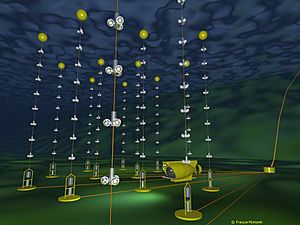ANTARES (telescope) facts for kids
ANTARES is a special kind of telescope that looks for tiny particles called neutrinos. It's located 2.5 kilometers (about 1.5 miles) under the Mediterranean Sea, near the coast of Toulon, France.
ANTARES stands for Astronomy with a Neutrino Telescope and Abyss environmental RESearch project. It's also named after the bright star Antares. This project is officially recognized by CERN, which is a big science organization.
The main goal of ANTARES is to find neutrinos that come from space, especially from the Southern Hemisphere of the Earth. It works with another neutrino detector called IceCube at the South Pole, which looks for neutrinos from both hemispheres. ANTARES finished collecting data in February 2022, after working for 16 years.
Contents
How ANTARES Works
ANTARES is made of twelve long strings that stand upright in the sea. Each string is about 350 meters (1,150 feet) long and has 75 special light sensors called photomultiplier tubes. These strings are anchored to the seabed about 2.5 kilometers deep, and they are placed about 70 meters (230 feet) apart from each other.
When certain types of neutrinos, called muon neutrinos, travel through the Earth and hit the water in the Mediterranean Sea, they can create a high-energy particle called a muon. As this muon moves through the water, it gives off a faint blue light, similar to a sonic boom, called Cherenkov radiation. The photomultiplier tubes in ANTARES are designed to detect this light.
Scientists can tell the difference between muons coming from space (which they want to study) and other muons created in Earth's atmosphere. This helps them focus on the neutrinos from distant cosmic sources.
Water vs. Ice Detectors
Unlike other neutrino telescopes like IceCube at the South Pole, which use ice, ANTARES uses water. Light travels through water with less scattering than in ice. This means ANTARES can get a clearer picture of where the neutrinos came from.
However, sea water has more natural light sources, like radioactive materials and tiny glowing sea creatures. This makes it harder to detect the faint Cherenkov light, so ANTARES needs very clever ways to filter out this extra light.
Building ANTARES
The construction of ANTARES was finished on May 30, 2008. The first string of light sensors was put into place in February 2006. Over the next two years, the other strings were added and connected.
By January 2007, ANTARES became the largest neutrino telescope in the Northern Hemisphere. By May 2008, all twelve strings were working together.
French oceanographic experts from IFREMER helped with the building process. They used special underwater robots called ROVs, like Victor, and sometimes even a submarine called Nautile, to deploy and connect the detector parts deep underwater.
What ANTARES Studies
ANTARES helps scientists learn more about the universe. It works with the IceCube Neutrino Observatory in Antarctica to cover different parts of the sky. Because of its location, ANTARES is especially good at detecting neutrinos with lower energies (from 10 GeV to 100 TeV) coming from the southern sky. This area includes many interesting sources within our own galaxy.
Over its years of operation, ANTARES aimed to create a map of where cosmic neutrinos come from in the Southern Hemisphere. Scientists are very interested in finding specific "point sources" of neutrinos, which could be linked to other powerful events in space, like gamma-ray bursts observed by telescopes such as HESS in Namibia.
ANTARES also helps with big questions in particle physics. Scientists used it to search for dark matter, which is a mysterious substance that makes up a large part of the universe. They looked for signs of dark matter particles called neutralinos, especially if they were to collide and disappear (annihilate) in the Sun or at the center of our galaxy. Finding these signals would also support a theory called supersymmetry.
Early Discoveries
The first detections of neutrinos by ANTARES were announced in February 2007.
After analyzing six years of data, scientists searched for neutrino sources near the center of our galaxy but didn't find any specific ones. They also studied how atmospheric neutrinos change as they travel, a process called neutrino oscillations.
Other Instruments on ANTARES
Besides the main neutrino detector, ANTARES also has other tools to study the deep-sea environment. These include sensors to measure the saltiness of the water, the amount of oxygen, and how ocean currents move. There are also instruments to check how light travels through the water and the speed of sound.
A camera system was installed to automatically track glowing sea creatures, which are important for understanding the background light in the detector. The information from these instruments is shared with ocean science groups.
ANTARES also has a special acoustic system called AMADEUS. This system uses hydrophones (underwater microphones) to listen for sounds. Scientists are exploring if they can use sound to detect very high-energy neutrinos in the deep sea.
See also
 In Spanish: ANTARES (telescopio) para niños
In Spanish: ANTARES (telescopio) para niños
- P-ONE


